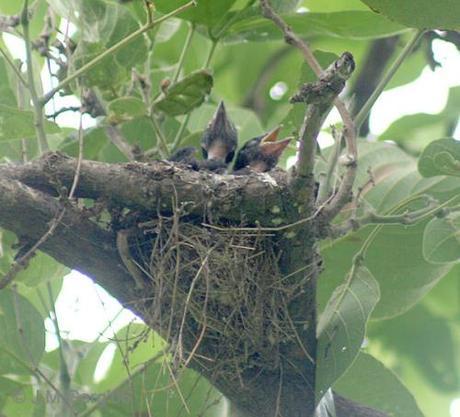Dicrurus macrocercus

This striking photo of a Black Drongo (and its reflection in water) about ready to catch an insect was one of the entries in the 2012 National Geographic Photography Contest. The photo was taken by Vinayak Parmar who spent an hour every morning for 10 days, sitting quietly and motionlessly, waiting to capture this moment on October 25, 2012. [Source]
The Black Drongo (Dicrurus macrocercus) is a small Asian passerine bird of the drongo family Dicruridae. It is common in much of tropical southern Asia from southwest Iran through India and Sri Lanka east to southern China and Indonesia.
It is a wholly black bird with a distinctive forked tail and measures 11 inches in length. Feeding on insects, it is common in open agricultural areas and light forest, perching conspicuously on a bare perch or along power or telephone lines.
Black Drongos are aggressive and fearless, and will attack much larger birds that enter their nesting territory, including crows and birds of prey. Smaller birds often nest in the well-guarded vicinity of a nesting Black Drongo.
Black Drongos become active very early at dawn and roost later than many other birds. They feed mainly on insects such as grasshoppers, cicadas, termites, wasps, bees, ants, moths, beetles and dragonflies, but seem to avoid flies. They sometimes fly close to tree branches, attempting to disturb any insects that may be present. They congregate in fields that are being ploughed, picking up exposed caterpillars and beetle grubs. As many as 35 birds have been seen at such congregations.

Black Drongos breed mainly in February and March in southern India, and until August in other parts of the country. Males and females sing in the mornings during the breeding season. Courtship can include aerobatic chases and they may lock their wings and beaks together, with the pair sometimes falling to the ground. Pair bonds are retained for a whole breeding season. The nest is a cup made with a thin layer of sticks placed in the fork of branch, and is built in a week by both the male and female.
The usual clutch is three or rarely four eggs laid in a cup nest placed in the fork of an outer branch of tree, preferably large leafy trees such as the Jackfruit. The eggs, pale cream to red with spots and markings, are incubated by both parents and hatch after 14 to 15 days. Offspring from the previous brood sometimes assist in feeding the fledglings at the nest of their parents.
~Eowyn

